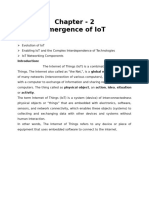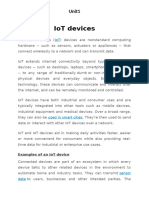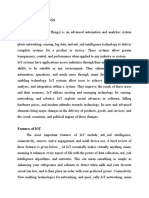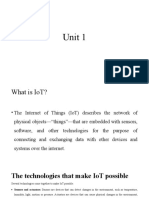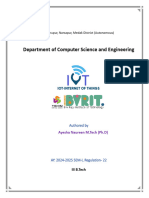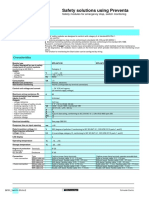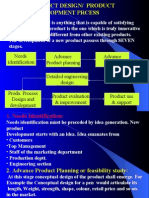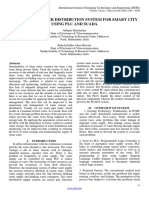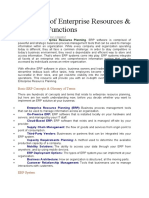DSV
DSV
Uploaded by
megsuchihaCopyright:
Available Formats
DSV
DSV
Uploaded by
megsuchihaOriginal Description:
Original Title
Copyright
Available Formats
Share this document
Did you find this document useful?
Is this content inappropriate?
Copyright:
Available Formats
DSV
DSV
Uploaded by
megsuchihaCopyright:
Available Formats
2.
2 IoT Gateways
As the number of devices connected to the IoT grow in number, we see an increasing
need to connect devices of varying functionality to the internet. One of the most
critical components however, are devices known as the IoT gateways. An IoT gateway
aggregates sensor data, translates between sensor protocols, processes sensor data
before sending it onward and more. When we consider how IoT as a platform has come
up in recent times, it is very much understandable as to why there is an increase
in the importance of IoT gateways.
Consider the use case of an IoT-connected office building environment. Sensors and
the IoT equivalent of our five senses. But instead of five, these are hundreds of
sensors with dozens of different functions, such as measuring temperature, ambient
light, noise or sound levels, areas in the office with higher activity, the
security systems and so on. However, when we talk of IoT as a system, sensing such
variables is only one half. The other half lies in controlling these variables or
systems that have a direct or indirect effect on the said variables. Such as
turning on and off the lights, switching the air systems off if the temperature
falls below a given threshold and so on. Each of these devices may use different
protocols to connect, such as Wi-Fi, Bluetooth, Serial ports, Ethernet, MQTT and
others. The requirement of these devices is ever increasing however, having
components connect individually back to the systems that need their data is not
often possible. Some sensors and controllers use very low energy and do not support
energy intensive protocols like Wi-Fi or Bluetooth, and therefore cannot connect
directly. Some devices generate a large amount of data that is not valuable in its
raw form. That is exactly where IoT gateways come into picture. It performs several
critical functions such as device connectivity, protocol translation, data
filtering and processing, security and more. Newer IoT gateways also operate as
platforms for application code that processes data and becomes an intelligent part
of a device-enabled system.
IoT gateways sit at the intersection of edge systems that is, devices controllers
and sensors; and the cloud. When we look at traditional gateways, they have mostly
performed protocol translation and device management functions. They were not
intelligent, programmable devices that could perform-in-depth and complex
processing on IoT data. Todays �smart IoT gateways, developed by various companies
are full-fledged computing platforms running modern operating systems and they are
called �Intelligent gateways�
In order for us to achieve efficient results when it comes to the IoT gateways, a
certain number of function criterions need to be met. That is:
� Trusted connectivity and security: Ensuring the integrity of the system is
the essential role of the IoT gateway. Especially when we have a large number of
sensors connected to the system, the communication of these sensors need to be done
over a secure and robust network which is provided by the IoT Gateways.
� Protocol and data bridge: Being able to translate and transfer data among and
between systems operating with different communications protocols and data formats
is required since the number of devices connected to the system are varying in many
aspects.
� Storage and analysis: On board application development platforms and storage
to drive intelligence and decision making closer to the device.
You might also like
- D905 Kubota Diesel Engine ManualDocument6 pagesD905 Kubota Diesel Engine ManualJose Muñoz50% (2)
- God's Last, Best Gift To Mankind - Gnostic Science and The Eschaton in The Vision of John Murray Spear PDFDocument23 pagesGod's Last, Best Gift To Mankind - Gnostic Science and The Eschaton in The Vision of John Murray Spear PDFVanniNo ratings yet
- Bext 360Document4 pagesBext 360Ruben Dario SortoNo ratings yet
- Electronic Data Backup SOPDocument8 pagesElectronic Data Backup SOPMLastTryNo ratings yet
- TempleteDocument26 pagesTempleteprincerudra7978No ratings yet
- Rushat IOTDocument46 pagesRushat IOTCharveer “CHARVEERTV” tvNo ratings yet
- Chapter-2 IoT FinalDocument16 pagesChapter-2 IoT FinalPutta SwamyNo ratings yet
- Chapter-2 IoT FinalDocument15 pagesChapter-2 IoT FinalPutta SwamyNo ratings yet
- IoT Unit IDocument13 pagesIoT Unit ITejaswini PawarNo ratings yet
- Module I - IoTDocument9 pagesModule I - IoTshashank kumarNo ratings yet
- Internet of Things (IOT)Document31 pagesInternet of Things (IOT)Syed Rakshaan IsrarNo ratings yet
- Unit-III-part 1Document29 pagesUnit-III-part 1amitlovanshi4568No ratings yet
- iotDocument43 pagesiot720822106055No ratings yet
- IoT WriteupDocument21 pagesIoT WriteupShiv KumarNo ratings yet
- Index Topic Coverage For UNIT 1,2Document35 pagesIndex Topic Coverage For UNIT 1,2sajwanisanskar3No ratings yet
- Unit 1 1Document19 pagesUnit 1 1AbinayaNo ratings yet
- IOT CharacteristicsDocument31 pagesIOT Characteristicsnandutripathi138No ratings yet
- Unit 1Document40 pagesUnit 1studyexpress12No ratings yet
- Introduction To Iot and OverviewDocument49 pagesIntroduction To Iot and OverviewSivagami ManiNo ratings yet
- IotDocument38 pagesIotrdbcslab2k23No ratings yet
- Unit-4 Etie NotesDocument5 pagesUnit-4 Etie NotesAlpesh ThesiyaNo ratings yet
- ICPA notesDocument15 pagesICPA notesdevi.gNo ratings yet
- Unit-2 IotDocument53 pagesUnit-2 IotkaveripadmabaswaNo ratings yet
- IoT REPORT Raj Deep YadavDocument34 pagesIoT REPORT Raj Deep YadavRaj DeepNo ratings yet
- Internet of ThingsDocument5 pagesInternet of ThingsCrispNo ratings yet
- Introduction To Internet of Things (Iot)Document97 pagesIntroduction To Internet of Things (Iot)bijalrana173No ratings yet
- IoT Architecture Unit1Document4 pagesIoT Architecture Unit1preethimanikandan2012No ratings yet
- IoT Module-1Document21 pagesIoT Module-1thalivathamilNo ratings yet
- IoT EcosystemDocument7 pagesIoT EcosystemNiranjan SinghNo ratings yet
- Architecture of Internet of Things (IoT) - GeeksforGeeksDocument8 pagesArchitecture of Internet of Things (IoT) - GeeksforGeekssehranreshiNo ratings yet
- IOT WorkshopDocument13 pagesIOT WorkshopPraveen BandiNo ratings yet
- The Internet of ThingsDocument8 pagesThe Internet of ThingstejasNo ratings yet
- IoT Lecture Fall 2024Document19 pagesIoT Lecture Fall 2024syedhmz384No ratings yet
- Department of Computer Science: Pachamuthu College of Arts and Science For Women DharmapuriDocument128 pagesDepartment of Computer Science: Pachamuthu College of Arts and Science For Women DharmapuriJesiNo ratings yet
- Internet of Things TutorialDocument39 pagesInternet of Things TutorialTAMIRE SANTOSH MOHANNo ratings yet
- Unit 1-I B.Tech (IoT)Document15 pagesUnit 1-I B.Tech (IoT)Maitrayee SuleNo ratings yet
- Iot OverviewDocument7 pagesIot OverviewRÂEES PUBGNo ratings yet
- Iot Unit1Document41 pagesIot Unit1Apoorv GanavdiyaNo ratings yet
- CHAPTER 1 OrganizedDocument6 pagesCHAPTER 1 OrganizedJayanth ReddyNo ratings yet
- Unit 3 - Internet of Things - WWW - Rgpvnotes.inDocument18 pagesUnit 3 - Internet of Things - WWW - Rgpvnotes.inAnurag MaithaniNo ratings yet
- Group 5Document14 pagesGroup 5rachealmwubaha8No ratings yet
- Unit 1 IotDocument34 pagesUnit 1 Iotjose2985No ratings yet
- Notes 2Document7 pagesNotes 2Vivekandhan NNo ratings yet
- Internet of Things MaterialDocument117 pagesInternet of Things MaterialAyesha Naureen KhanNo ratings yet
- Introduction To Iot Chapter 2 NotesDocument25 pagesIntroduction To Iot Chapter 2 NoteskpadmajaNo ratings yet
- Untitled DocumentDocument15 pagesUntitled DocumentbommireddyrishitaNo ratings yet
- Characteristics of IoTDocument3 pagesCharacteristics of IoTakramshaik2004No ratings yet
- chapter 4 Internet of thingsDocument34 pageschapter 4 Internet of thingsgebremikaelaweta4No ratings yet
- Unit IiiDocument78 pagesUnit IiiHashidh DNo ratings yet
- Architecture of Internet of ThingsDocument3 pagesArchitecture of Internet of ThingsYoganathan BNo ratings yet
- IOT Embedded systemsDocument54 pagesIOT Embedded systemsshruti JadhavNo ratings yet
- What Is The Internet of ThingsDocument9 pagesWhat Is The Internet of Thingsshilpamjadhav2020No ratings yet
- IoT Unit IDocument72 pagesIoT Unit Iaakaankshaagupta20No ratings yet
- Unit 1 - Internet of Things - WWW - Rgpvnotes.inDocument15 pagesUnit 1 - Internet of Things - WWW - Rgpvnotes.inAnurag MaithaniNo ratings yet
- 60b69a03609f7bbbbb86ea8b - IoT Architecture White Paper - HologramDocument10 pages60b69a03609f7bbbbb86ea8b - IoT Architecture White Paper - HologramMike HollandNo ratings yet
- SupervisionDocument27 pagesSupervisionfehixa6948No ratings yet
- Chapter Four Introduction To Internet of Things (Iot) What Is An Internet of Things (Iot) ?Document10 pagesChapter Four Introduction To Internet of Things (Iot) What Is An Internet of Things (Iot) ?Mubaarak NuurNo ratings yet
- Internet of Things - CHP 1Document21 pagesInternet of Things - CHP 1rohanoza1450No ratings yet
- Internet of ThingsDocument15 pagesInternet of ThingsArshdeep SinghNo ratings yet
- What Is IoT ArchitectureDocument3 pagesWhat Is IoT ArchitectureliyomNo ratings yet
- Unit 1: IotDocument79 pagesUnit 1: Iotbiswadeepbasak0212No ratings yet
- Chapter 4 IOT of Emerging TechnologyDocument19 pagesChapter 4 IOT of Emerging TechnologyAddisalem GanfureNo ratings yet
- Emerging Technology Overivew of Iot Unit-I Part-1Document21 pagesEmerging Technology Overivew of Iot Unit-I Part-1Manya JaiswalNo ratings yet
- Safety Solutions Using Preventa: Operating Principle, CharacteristicsDocument4 pagesSafety Solutions Using Preventa: Operating Principle, CharacteristicsJmbNo ratings yet
- Product Reliability UpdateDocument46 pagesProduct Reliability Updatebhadrakali9861268344No ratings yet
- Stusb 1602Document39 pagesStusb 1602BETSO ELECTRONICSNo ratings yet
- Thank You For Purchasing A Corel License.: Yp S.A. Ruta 2 Mcal. Estigarribia Km. 38 - Ypacaraí Ypacarai ParaguayDocument2 pagesThank You For Purchasing A Corel License.: Yp S.A. Ruta 2 Mcal. Estigarribia Km. 38 - Ypacaraí Ypacarai ParaguayJorge CabreraNo ratings yet
- Software EngineeringDocument12 pagesSoftware EngineeringSwaraj DeshmukhNo ratings yet
- Cimb Bank Credit Card Pinpay Faq 12102016Document8 pagesCimb Bank Credit Card Pinpay Faq 12102016Hafiz AbdulNo ratings yet
- Detroit Diesel Diagnostic CodesDocument21 pagesDetroit Diesel Diagnostic CodesVolvo TrucksNo ratings yet
- Review Change Analysis Charts KeyDocument12 pagesReview Change Analysis Charts Keyapi-237861864100% (1)
- Automated Water Distribution System For Smart City Using PLC and ScadaDocument4 pagesAutomated Water Distribution System For Smart City Using PLC and ScadaijeteeditorNo ratings yet
- Inverter 15 Seer PDFDocument4 pagesInverter 15 Seer PDFtiempofrio5108No ratings yet
- DX DiagDocument51 pagesDX DiagcacakNo ratings yet
- SAP EWM Sample Resume 1Document4 pagesSAP EWM Sample Resume 1Ahamed33% (3)
- Cep 1Document17 pagesCep 1Nilamani Umashankar Jena100% (3)
- Erp Mba NotesDocument96 pagesErp Mba NotesAbhishek MishraNo ratings yet
- History of Morse CodeDocument12 pagesHistory of Morse CodeDiaz P AyuraNo ratings yet
- Cryptography and Number Theory - Presentation - MARSDocument21 pagesCryptography and Number Theory - Presentation - MARSsunil_38No ratings yet
- Sehs3317 L1Document73 pagesSehs3317 L1李里奧No ratings yet
- Summer Training Report 132 KV UPPCLDocument40 pagesSummer Training Report 132 KV UPPCLAadesh sharmaNo ratings yet
- Grade 9 - 2021 End of Year ExamDocument12 pagesGrade 9 - 2021 End of Year ExamSwayne BrownNo ratings yet
- Cisco Expressway Certificate Creation and Use Deployment Guide X12 5 PDFDocument44 pagesCisco Expressway Certificate Creation and Use Deployment Guide X12 5 PDFvst123No ratings yet
- Brochure Fisher Fieldvue Dvc2000 Digital Valve Controllers en 124728Document4 pagesBrochure Fisher Fieldvue Dvc2000 Digital Valve Controllers en 124728Kaushal ParmarNo ratings yet
- AV02-0717EN DS HCPL-316J 28mar2011Document33 pagesAV02-0717EN DS HCPL-316J 28mar2011Felipe LorenziNo ratings yet
- Product - Information - MI06-S-XX-400 V1.6Document2 pagesProduct - Information - MI06-S-XX-400 V1.6Jorge MorenoNo ratings yet
- Edy 424-Assignment #1Document4 pagesEdy 424-Assignment #1Martias WambiNo ratings yet
- How Do You Feel About Working Nights and Weekends - HR Interview Questions and AnswersDocument7 pagesHow Do You Feel About Working Nights and Weekends - HR Interview Questions and AnswersAhmed TahaNo ratings yet
- 24AE04Document34 pages24AE04tiberiusNo ratings yet






